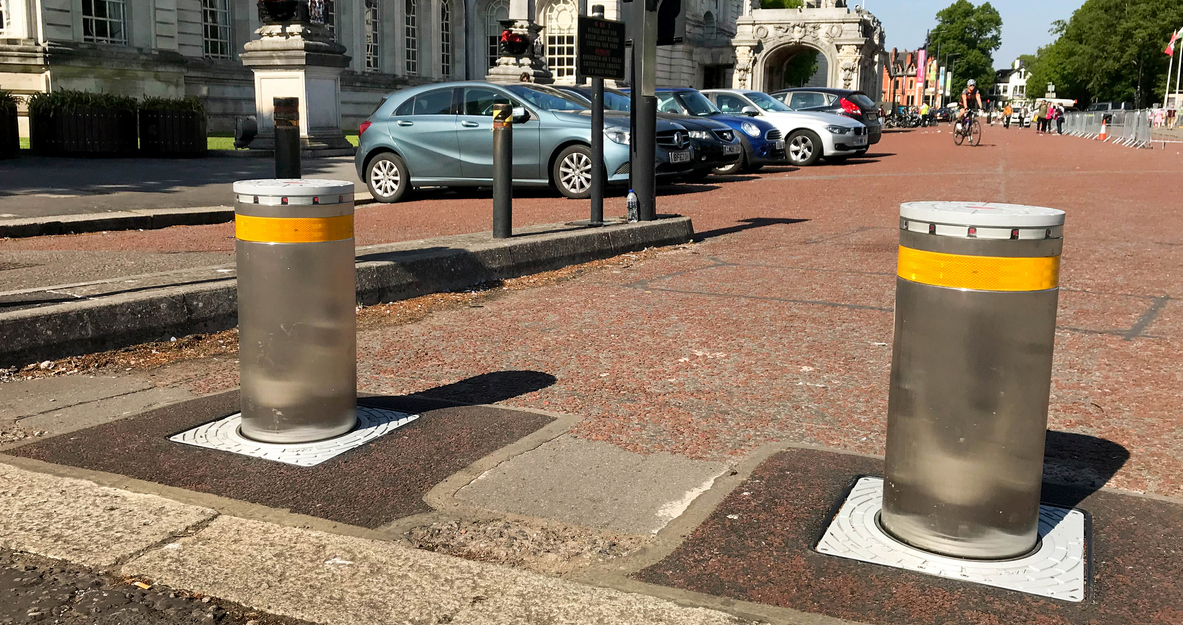1. Introduction
Hostile Vehicle Mitigation (HVM) is a protective security discipline focussing on reducing risks associated with vehicle borne threats ranging from vandalism to sophisticated or aggressive attacks by determined criminals or terrorists. Vehicles offer a convenient method to deliver a bomb, known as a vehicle-borne improvised explosive device (VBIED). A vehicle can also be used as a weapon that is used to drive into crowds to injure and kill people or used to ram and damage infrastructure.
The basis of HVM are security risk assessments, security planning, design and the deployment of risk-based measures.
The delivery of those risk-based measures are informed by the threat and how it manifests itself, the multiple consequences of an attack, the vulnerability of a given location and the needs of the owner requiring protection.
2. Vehicle-borne improvised explosive device VBIED
The immediate effects from a VBIED include the blast, fireballs, primary and secondary fragmentation and ground shock. The blast stand-off distance is the area around an explosion which is the single most important factor in determining the extent of damage that can be caused. This is location specific; it is important to maximise the blast stand-off distance to reduce the amount of damage caused by an explosion.
3. Vehicle as a weapon (VAW)
A vehicle by itself can be used as a weapon in order to injure and kill people, or ram and damage buildings and infrastructure: this is referred to as a vehicle as a weapon attack. The use of a VAW has been used by terrorists to target crowds and other publicly accessible locations. A broad range of vehicles can cause significant loss of life and serious injury.
There are seven main attack exploits used to carry out a vehicle borne attack (VBIED or VAW):
Parked
A vehicle may be parked close to an asset or inside the perimeter of a site or event space. The vehicle may be parked legitimately, illegally or without the land owner or event organiser’s consent. It may be deliberately parked repeatedly to create familiarity.
The vehicle may be abandoned or remain occupied for a short or considerable amount of time prior to the time of attack.
Unsecured parked vehicles within or outside a protected area may be utilised by the attackers.

Encroachment
A hostile vehicle may be able to:
-
exploit gaps in an urban/rural landscape or perimeter protection
-
drive slowly through or over what is perceived to be a perimeter or series of obstructions.
-
closely tailgate a legitimate vehicle through a single layer vehicle access control point (VACP).
Penetrative
A vehicle may be used at low or high speed to weaken and/or breach through security measures. A penetrative attack could result in an IED detonating in or close to an asset or a hostile vehicle entering a publicly accessible location. Lower speed attacks may involve the vehicle being aggressively and repetitively rammed against security measures or other obstructions to gain access.
Deception
A hostile vehicle may be modified to replicate a legitimate vehicle. The vehicle may look familiar by its make/model, vehicle registration number and livery.
The occupant(s) of a vehicle may use a pretence to gain site access. The occupant(s) may lie, or have forged/stolen documentation to gain access, use disguises to appear genuine or try to distract/confuse the security office(s) to gain access.
A legitimate driver may be an unknowing mule by delivering a hidden IED, firearms, weapons and/or attackers into a protected area.
Duress/coercion
A security officer at a vehicle access control point (VACP), a legitimate driver or other person could be forced to facilitate hostile access into a site. They or others known to them may be threatened with violence. They may be placed under undue influence through mental pressure.
Insider
A person with legitimate access willingly facilitates an attack by operating the security measures locally or remotely, managing or issuing access rights or tampering with the security measures
Tamper/Sabotage
With the intent of leaving no evidence, this attack facilitates hostile vehicle access at a later time. This may involve altering, weakening, or disabling a barrier and/or associated security systems. This may be a physical or cyber-attack that occurs gradually over time or immediately before an attack. An aggressive physical attack on the barriers, at or just before, may facilitate a fast-moving attack.
4. Mitigating a VAW attack or VBIED
Threats from vehicles can be mitigated by installing physical measures which can be blended into the landscape or streetscape. These may be passive (static) or active (security controlled) and can be installed either on a permanent or temporary basis.
These measures should meet appropriate standards in terms of their vehicle impact performance, design and installation. Further information can be found in section ‘Standards, Testing and Products’.
The measures used will depend on the operational requirements applicable to the site. Further information can be found in section ‘Operational Requirements’
Hostile Vehicle Mitigation (HVM) measures
HVM measures are the integrated deployment of security processes, procedures and physical obstructions to counter vehicle borne threats.
They typically include:
-
deterrent communications
-
security awareness
-
incident response planning and training
-
operational security
-
traffic exclusion and management
-
deployment of physical obstructions such as vehicle security barriers and traffic calming measures.
Traffic exclusion and management
These are various risk-based HVM schemes, which should be considered when looking at protecting publicly accessible locations which may include:
-
total traffic exclusion (no vehicles allowed)
-
controlled vehicle inclusion (some vehicles allowed)
-
footway protection (pedestrians on the pavement)
-
traffic calming (shared space)
-
semi-permanent protection (permanent barriers occasionally closed)
-
temporary protection (short term deployment of portable barriers)
-
do nothing (no protection)
Visit CPNI's hostile vehicle mitigation for more information.
4.2 Deployment of physical obstructions such as vehicle security barriers and traffic calming measures.
Vehicle Security Barriers (VSBs)
Permanent VSBs include:
-
bollards (active, retractable and passive static)gates
-
rated streetscape products such as planters, benches, and street furniture
-
ditches, bunds and berms
Semi-Permanent VSBs:
The repeated renting of temporary barriers is expensive; sites should therefore consider a contingency barrier scheme. These are typically pre-installed gated VSBs in the relevant areas, which can be closed just prior to the event or pre-installed foundation sockets in to which passive or active VSBs are slotted. This avoids the loss of lane availability during the installation of temporary barriers on the days/nights prior to an event; which is beneficial to both communities and transport authorities.
Temporary VSBs include:
There are temporary VSBs, which are either surface mounted or pinned to the ground. These come in a range of solutions such as:
-
bollards
-
gates
-
lightweight VSBs
Some temporary VSBs are designed to be lightweight and surface mounted to allow pedestrian access for temporary events.
The National Barrier Asset
The National Vehicle Threat Mitigation Unit (NVTMU) is a police unit within the National Counter Terrorism Security Office (NaCTSO), which administers the National Barrier Asset (NBA).
The NBA is a substantial collection of surface-mounted temporary hostile vehicle mitigation (HVM) available for use by both the public and private sectors at relatively little cost.
The NVTMU has expertise in mitigating the risk from a vehicle attack (known as Vehicle as a Weapon (VAW) attacks) and the deployment and use of the NBA.

